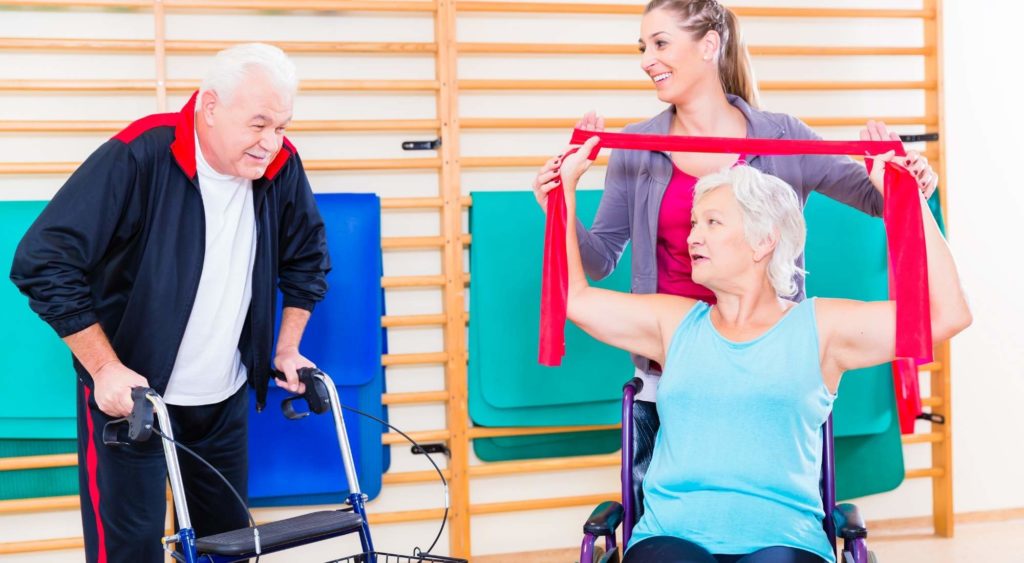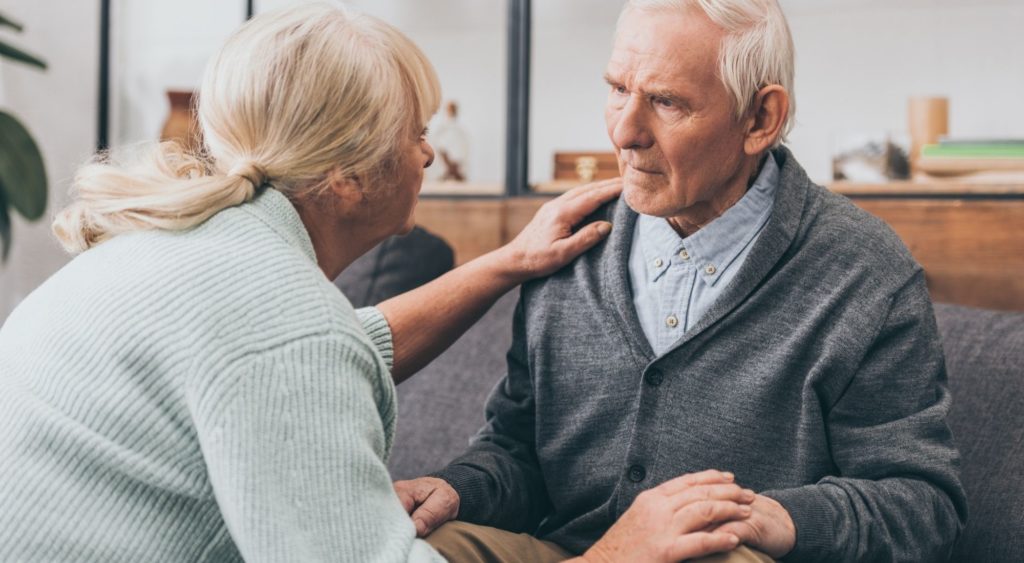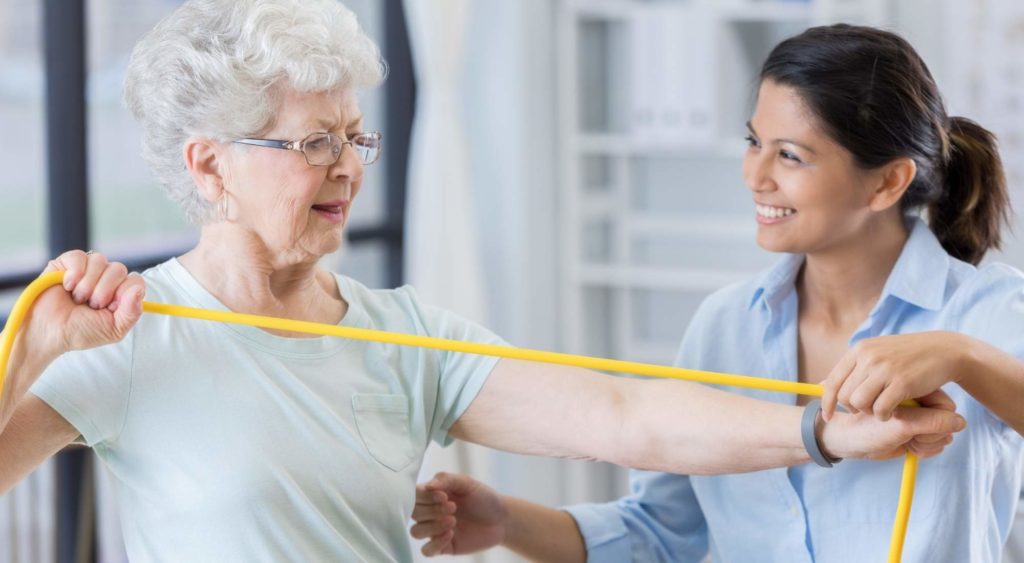
Every year, around 10 million people are diagnosed with dementia.
As people begin exploring their options for minimizing the effects of dementia and working to maintain independence, many turn to physical therapy.
Whether you have recently been impacted by a dementia diagnosis or you are simply gleaning information in case you need it someday, you are probably curious about the connection between physical therapy and dementia.
Whatever your reason for seeking information, you have come to the right place.
In this guide, we will walk you through what physical therapy and dementia care look like when put together as well as the …
- Physical
- Emotional, and
- Social
… benefits of physical therapy for dementia patients.
Table of Contents
- Does Physical Therapy Help Dementia Patients?
- Physical Therapy and Dementia Patients: 3 Types of Benefits
- Physical Therapy and Dementia Care: Learn How In Motion O.C. Can Help
Does Physical Therapy Help Dementia Patients?
Yes. Physical therapy can help dementia patients.
According to one study, maintaining a level of engagement in physical activities is one of the most essential parts of non-pharmaceutical care for dementia patients. Physical therapy can help patients regain balance and improve both physical and mental health.

Physical Therapy and Dementia Patients: 3 Types of Benefits
There are many different benefits when it comes to physical therapy and dementia patients.
Physical therapy and dementia care go hand-in-hand, and it is important to know the benefits — both physical and otherwise — that physical therapy can provide.
For instance, physical therapy can help with:
- Physical health
- Emotional health
- Social health
#1: Physical Benefits
Not surprisingly, one of the main domains that physical therapy affects is physical health. One could say it is the name of the game.
There are a multitude of physical benefits that you can gain from investing in physical therapy that go far beyond better posture and post-op recovery.
Improve Balance and Gait
Balance is crucial. It keeps you on your feet and moving forward.
Physical therapy is a great way to help improve your balance and decrease your risk of falling.
While falling is a danger that many seniors face, it can be a bigger issue for dementia patients.
Physical therapy can help minimize this threat.
For some dementia patients, remembering the process of standing and walking can be a challenge, and they may find themselves falling frequently.
For instance, as we age, our blood pressure is affected, and the change between sitting and standing can throw us off.
It is important to wait a moment to walk after standing to help prevent falls.
However, for some dementia patients, remembering to wait before walking can be difficult, leading to being thrown off balance and, potentially, falling.
A great tool to help with balance is gait training, which can be offered in physical therapy. Gait Training equipment ranges from crutches to walkers and beyond.
Gait refers to a person’s pattern of walking and, while it sounds simple, it is quite complex.
For example, your gait is so unique to you that it is similar to a fingerprint. It can be used to identify you. Some researchers say that gait recognition functions with up to 99.3% accuracy.
With how complex it is, it is no shock that poor gait can lead to falls and injuries.
Physical therapy can help improve balance and gait, leading to a reduced chance of falling and the ability to regain balance when thrown off.
Here at In Motion O.C., we have created a special fall prevention program designed to help you stay stable.
Relieve and Strengthen Stiff Muscles
Another great physical benefit to physical therapy is that it can help relieve — and strengthen — stiff muscles.
Dementia affects more than just the brain.
It can affect your muscles, too.
Physical therapy helps to alleviate stiff muscles through different
- Stretching techniques
- Exercises, and
- Therapies
Physical therapy can help alleviate those peskily stiff and sore muscles and even help strengthen them.
Improve Cardiovascular Health
When it comes to the musculoskeletal system, physical therapists are experts.
It is their job to know what affects what and how to make it all work together well.
Physical therapists also know all about the heart and how it is affected by physical activity.
Physical therapy can help you regain:
- Flexibility
- Strength
- Confidence
Physical therapy exercises are heart-healthy and are meant to be incorporated into your daily routine.
Not only that, but when we exercise, it often helps clear our minds. This can help dementia patients manage some of the symptoms they face.
Additionally, physical therapists can recommend different forms of activity that will best suit your body.
By participating in physical therapy, you are helping your body function at its best.
#2: Emotional Benefits
At In Motion O.C., we care about more than just your physical health.
Did you know that physical therapy can promote better emotional health?
It’s true.
Physical activity helps release endorphins which signal feelings of happiness and tranquility.
Not only can physical therapy help release endorphins, but it can also serve to boost confidence and self-trust, two things directly tied to emotional well-being.
Improve Cognition
Cognition is the mental process by which you take in information and use it in your everyday life.
It is believed that physical therapy can help to improve cognitive function.
Studies show that physical therapy can minimalize or delay dementia symptoms.
This is partially due to the relationship between the flow of blood and the function of the brain.
While the average human brain only weighs around 3 pounds, it gets roughly 15% of your blood flow, meaning that when you get your blood pumping, it circulates in the brain, helping to encourage alertness and a physically healthy brain.
Physical therapy and dementia care are not two separate entities — they can work together to help patients achieve their highest possible quality of life.
Motivate Dementia Patients and Increase Quality of Life
Have you ever woken up without a list of things to do and then gone through your day feeling unmotivated and unable to enjoy or time or be productive?
Dementia patients can experience that feeling quite often.
Now, imagine you woke up with a plan to work out and then continue the pattern of making healthy choices and productivity.
Suddenly your day has more of a purpose and you have more motivation.
Having a routine of physical therapy exercises can help offer dementia patients more motivation and a higher quality of life.
As we accomplish things, we feel good and productive.
These feelings can go a long way for dementia patients.
The confidence boost isn’t the only thing that improves a dementia patient’s quality of life when it comes to physical therapy.
As patients complete physical therapy routines and experience the benefits, their bodies become healthier, and the mental degeneration can slow, allowing them to think more clearly and experience better physical health and comfort.
Physical therapy helps more than just joints.
Our team at In Motion O.C. wants to help you experience a better quality of life.
To better serve you, we have three different locations in California.

#3: Social Benefits
In addition to physical and emotional benefits, physical therapy can offer dementia patients some social benefits.
Reduce Social Anxiety
Social anxiety is on the rise for both the general public and dementia patients.
While our society is pushing to destigmatize illness, both physical and mental, there is still a stigma that seems to shroud dementia, and that can lead to social anxiety for patients.
They might be afraid of:
- Falling
- Forgetting something and looking foolish
- Embarrassing themselves
- Others seeing their anxiety
Physical therapy can help alleviate a lot of those fears. For instance:
- Physical therapy improves balance, reducing falls.
- Physical therapy can help stimulate the mind.
- Physical therapy builds confidence and resilience, leading to less self-consciousness.
- Physical therapy can help alleviate other anxiety-inducing moments, leading to less anxiety being present, to begin with.
Help Build Stronger Social Connections
Physical therapy can even help boost social connections.
Attending physical therapy sessions — particularly group sessions — can provide patients with the opportunity to socialize and spend time with others.
It also helps to improve the patient’s quality of life, enabling many to spend more time outside of their home.
Physical therapy can help build stronger social health and connections:
- Group therapy creates opportunities for socialization;
- Physical therapy boosts confidence, leading to stronger social experiences;
- Physical therapy can help patients achieve a higher degree of independence, leading to a greater ability to leave home and spend time with others.

Physical Therapy and Dementia Care: Learn How In Motion O.C. Can Help
Here at In Motion O.C., we’re committed to helping you or your loved one through the difficulties of dementia.
When it comes to physical therapy and dementia care, In Motion O.C. has you covered.
Our team of skilled therapists is here to help you or your loved one find solutions that:
- Build confidence
- Slow mental degeneration
- Keep the quality of life as high as possible
Dementia is a difficult journey, and no one should have to walk it alone.
In Motion O.C. is here to walk with you.



